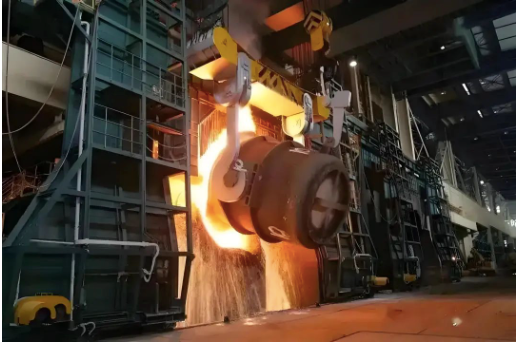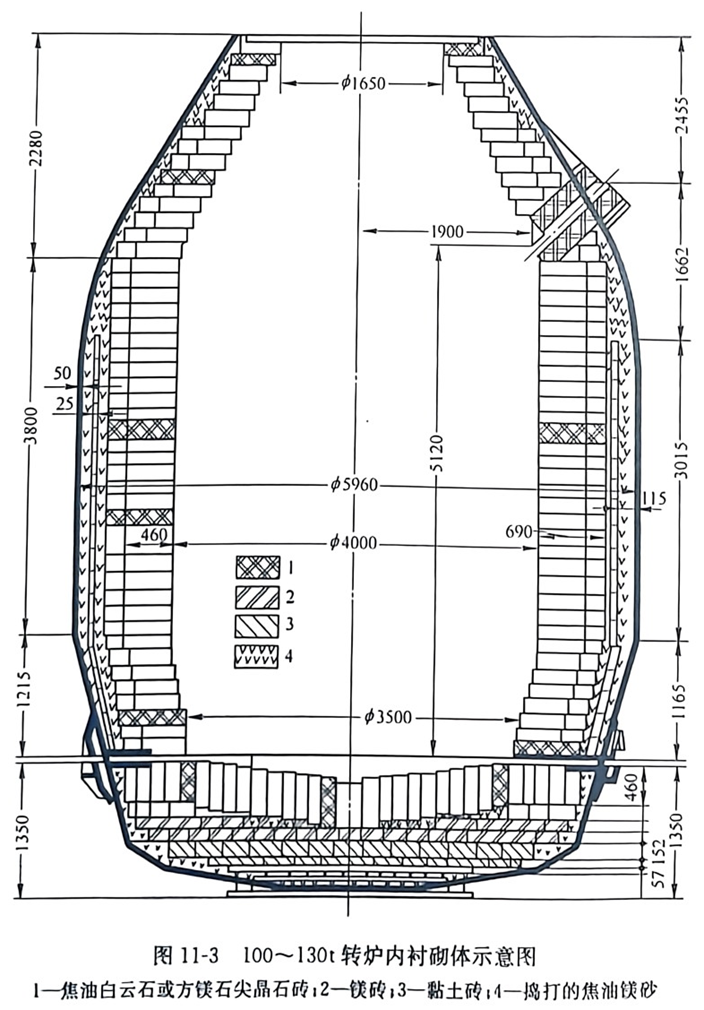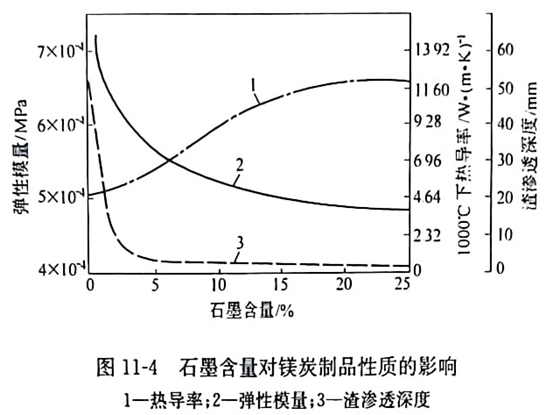氧气转炉中,相关耐火材料的使用条件
(一)各国用耐火材料概况
一些国家由氧气转炉已经完全取代了平炉。我国于1998年也完成了取代工作。在氧气转炉中的耐火材料受到碱性渣,氧化还原气体,约在1700℃温度下的金属和由于金属和渣紊流式循环的激烈机械磨损作用。氧气转炉普遍砌筑CaO-MgO-C系耐火材料,以镁炭砖最为盛行,各国不尽相同,日本倾向全部用不同品位的镁炭砖。但欧洲国家采用沥青结合的镁炭砖,含炭白云石(或镁白云石)砖综合砌炉。使用寿命虽然不比日本的全砌镁炭砖高,但成本低,经济效益好。

在焦油镁白云石制品中,随着强化转炉生产,MgO/CaO的比例不断提高。白云石制品含游离石灰,虽说焦油结合剂预防石灰水化,可是成型过程白云石大颗粒部分开裂,形成新鲜表面,没有焦油保护。制品 CaO含量提高,水化的稳定性降低。尽管各国炉衬的材质不相同,但要求原料纯,烧结或电熔,即采用精料意见是一致的。
(二)炉衬各部位使用条件
由于转炉内衬各部位工作条件的差异和操作因素的影响,炉衬侵蚀速度极不均匀,耳轴、渣线、炉帽、出钢口等部位过早损坏,其余部位虽然完好,但整个内衬无法使用。因此转炉内衬一般利用5~7种不同类型的耐火材料,分别砌筑不同部位,如焦油白云石或镁白云石制品为炉衬主体。此外,采用烧成镁质制品浸焦油或不浸焦油等。图11-3所示为某国100~130t转炉内衬砌体。高纯氧化镁或高纯镁白云石制品,甚至本身是坚固而抗渣的烧成耐火材料,作为转炉内衬,其中没有碳成分不能有效的工作,因为制品工作层很快被渣浸透,并在热应力下剥落。碳在工作面附近变成细晶石墨,不被润湿限制渣往耐火材料中渗入的深度。

因此,转炉耐火材料力求增加碳含量。最简单的方法是在氧化物耐火材料中加入碳。制取不烧的镁炭制品时,在配料中加入石墨,并与焦油沥青结合剂一起使制品中碳含量达到23%。这种制品的损毁速度最小为0.66mm/炉。可是在出钢的高温下,由于碳强化方镁石还原反应到气体状态,发现制品的寿命降低很多。镁炭耐火材料中,石墨含量对渣渗入深度和制品其他某些性质的影响如图11-4所示。从曲线图上看出:碳为5%时,渣渗透已经明显减小。当碳含量比较大时,从本质上提高镁碳质耐火材料内衬的寿命。因而碳不仅阻挠渣渗透,然而本身又限制耐火材料的渣化过程。

Conditions of use for refractories in oxygen converter
(1) Overview of refractory materials used in various countries
In some countries the oxygen converter has completely replaced the open hearth furnace. My country also completed its replacement in 1998. Refractories in oxygen converter are subjected to the action of alkaline slag, REDOX gas, metal at temperatures of about 1700 ° C and intense mechanical wear due to the turbulent circulation of metal and slag. Oxygen converter generally masonry CaO-MgO-C series refractories, magnesium carbon bricks are the most popular, different countries are not the same, Japan tends to use all different grades of magnesium carbon bricks. However, European countries use magnesium-carbon bricks combined with asphalt, and carboniferous dolomite (or magnesium-dolomite) bricks are integrated furnace building. Although the service life is not higher than that of Japan’s full magnesium-carbon brick, the cost is low and the economic benefits are good.
In the tar magnesia dolomite products, the ratio of MgO/CaO has been increasing with the strengthening of converter production. Dolomite products contain free lime, although tar binder to prevent lime hydration, but the molding process of dolomite large particles part cracking, forming a fresh surface, no tar protection. With the increase of CaO content, the stability of hydration decreases. Although the material of the furnace lining is not the same in various countries, the raw material is required to be pure, sintered or fused, that is, the use of concentrate is consistent.
(2) The use conditions of various parts of the furnace lining
Due to the difference in working conditions of each part of the converter lining and the influence of operating factors, the erosion rate of the lining is extremely uneven, and the trunnion, slag line, furnace cap, steel outlet and other parts are prematurely damaged. Although the other parts are intact, the entire lining cannot be used. Therefore, the converter lining generally uses 5 to 7 different types of refractory materials, respectively, the different parts of the masonry, such as tar dolomite or magnesium dolomite products as the lining body. In addition, burnt magnesium products are used to soak tar or not soak tar. Figure 11-3 shows the lining masonry of a 100-130t converter in a certain country. High purity magnesia or high purity magnesia dolomite products, even strong and slag-resistant fired refractory materials themselves, as the lining of the converter, which do not work effectively without a carbon component, because the working layer of the product is quickly saturated with slag and peeled off under thermal stress. The carbon is transformed into fine quartz ink near the working face, and the depth of infiltration into the refractory is not limited by the wetting slag.

Therefore, Bessemer refractories strive to increase carbon content. The simplest method is to add carbon to the oxide refractory. In the preparation of non-fired magnesium carbon products, graphite is added to the ingredients, and the tar pitch binder together to make the carbon content of the products up to 23%. The minimum damage rate of this product is 0.66mm/ furnace. However, at the high temperature of steel production, the life of the product is found to be much reduced due to the carbon strengthening of the reduction of magnesite to the gas state. In Mg-carbon refractories, the effect of graphite content on the penetration depth of slag and some other properties of the product is shown in Figure 11-4. As can be seen from the graph: when the carbon is 5%, the slag penetration has been significantly reduced. When the carbon content is relatively large, the life of magnesia-carbon refractory lining is essentially improved. Therefore, carbon not only obstructs the slag penetration, but also limits the slag process of the refractory itself.




